Occurrence and Analysis of Thermophilic Poly(butylene adipate-co-terephthalate)-Degrading Microorganisms in Temperate Zone Soils
Abstract
1. Introduction
2. Results
2.1. Screening for PBAT Degraders in Soils
2.2. Characterization of the PBAT-Degrading Consortia
2.3. Characterization of the PBAT-Degrading Community from Compost
3. Materials and Methods
3.1. Polymer Materials
3.2. Soil and Compost Characterization
3.3. PBAT Agar Plates and Enrichment of Thermophilic PBAT Degraders
3.4. Biodegradation Test in Compost
3.5. Scanning Electron Microscopy
3.6. DNA Analysis
4. Conclusions
- Mesophilic PBAT degraders are not present, or were not detected by the employed method due to their absence or extremely low numbers. On the contrary, the thermophilic degraders, although present in relatively low numbers in the investigated soils, are broadly present in the environment and so the availability of specific PBAT degraders does not represent a limiting factor for the composting treatment of this synthetic polymer.
- Thermophilic actinomycetes, Thermobispora bispora particularly, together with bacilli proved to be the key constituents of the isolated and characterized PBAT-degrading consortia as derived from both PCR-DGGE and NGS analysis of the isolated consortia. Similar patterns were also observed in the PBAT-degrading microbial community from the local composting plant.
- The attempts to isolate pure strains with the polymer as the sole carbon source failed, which suggested that the process requires the participation of more microorganisms.
- Actinomycetes and bacilli were the prevalent species in the initial phase of biodegradation in compost. Moreover, from microscopic analysis, filamentous bacteria with spores that could be morphologically assigned as actinomycetes were observed after nine days of incubation. These microscopy results, in conjunction with other evidence including experiments on agar plates, DGGE analysis and identification of the retrieved sequences, and NGS results, lead us to conclude that actinomycetes are important for PBAT biodegradation in compost.
Author Contributions
Funding
Conflicts of Interest
Abbreviations
| PBAT | Poly(butylene adipate-co-terephthalate) |
| NGS | Next generation sequencing |
| PCR-DGGE | Polymerase chain reaction-denaturing gradient gel electrophoresis |
| TPS | Thermoplastic starch |
| PLA | Poly(lactic acid) |
| TPSu | Thermoplastic starch with urea as plasticizer |
| PVA | Poly(vinyl) alcohol |
| SEM | Scanning electron microscopy |
| CFU | Colony forming units |
References
- Liu, J.; Xu, Y.; Xia, T.; Xue, C.; Liu, L.; Chang, P.; Wang, D.; Sun, X. Oxidized Oligosaccharides Stabilize Rehydrated Sea Cucumbers against High-Temperature Impact. Int. J. Mol. Sci. 2020, 21, 5204. [Google Scholar] [CrossRef]
- Wang, H.; Qian, J.; Ding, F. Emerging Chitosan-Based Films for Food Packaging Applications. J. Agric. Food Chem. 2018, 66, 395–413. [Google Scholar] [CrossRef]
- Lubkowski, K.; Smorowska, A.; Grzmil, B.; Kozłowska, A. Controlled-Release Fertilizer Prepared Using a Biodegradable Aliphatic Copolyester of Poly(butylene succinate) and Dimerized Fatty Acid. J. Agric. Food Chem. 2015, 63, 2597–2605. [Google Scholar] [CrossRef]
- Sintim, H.Y.; Bary, A.I.; Hayes, D.G.; Wadsworth, L.C.; Anunciado, M.B.; English, M.E.; Bandopadhyay, S.; Schaeffer, S.M.; Debruyn, J.M.; Miles, C.A.; et al. In situ degradation of biodegradable plastic mulch films in compost and agricultural soils. Sci. Total Environ. 2020, 727, 138668. [Google Scholar] [CrossRef]
- Sartore, L.; Schettini, E.; De Palma, L.; Brunetti, G.; Cocozza, C.; Vox, G. Effect of hydrolyzed protein-based mulching coatings on the soil properties and productivity in a tunnel greenhouse crop system. Sci. Total Environ. 2018, 645, 1221–1229. [Google Scholar] [CrossRef] [PubMed]
- Weng, Y.-X.; Jin, Y.; Meng, Q.-Y.; Wang, L.; Zhang, M.; Wang, Y. Biodegradation behavior of poly(butylene adipate-co-terephthalate) (PBAT), poly(lactic acid) (PLA), and their blend under soil conditions. Polym. Test. 2013, 32, 918–926. [Google Scholar] [CrossRef]
- Wang, J.; Wang, H.; Chen, E.; Chen, Y.; Wu, T. Enhanced Photodegradation Stability in Layered Zinc Phenylphosphonate. Polymers 2020, 12, 1968. [Google Scholar] [CrossRef]
- Pietrosanto, A.; Scarfato, P.; Di Maio, L.; Nobile, M.R.; Incarnato, L. Evaluation of the Suitability of Poly(Lactide)/Poly(Butylene-Adipate-co-Terephthalate) Blown Films for Chilled and Frozen Food Packaging Applications. Polymers 2020, 12, 804. [Google Scholar] [CrossRef]
- Witt, U.; Müller, R.-J.; Deckwer, W.-D. Biodegradation behavior and material properties of aliphatic/aromatic polyesters of commercial importance. J. Environ. Polym. Degrad. 1997, 5, 81–89. [Google Scholar] [CrossRef]
- Müller, R.-J.; Kleeberg, I.; Deckwer, W.-D. Biodegradation of polyesters containing aromatic constituents. J. Biotechnol. 2001, 86, 87–95. [Google Scholar] [CrossRef]
- Muroi, F.; Tachibana, Y.; Kobayashi, Y.; Sakurai, T.; Kasuya, K.-I. Influences of poly(butylene adipate-co-terephthalate) on soil microbiota and plant growth. Polym. Degrad. Stab. 2016, 129, 338–346. [Google Scholar] [CrossRef]
- Sangroniz, A.; González, A.; Martin, L.; Irusta, L.; Iriarte, M.; Etxeberria, A. Miscibility and degradation of polymer blends based on biodegradable poly(butylene adipate-co-terephthalate). Polym. Degrad. Stab. 2018, 151, 25–35. [Google Scholar] [CrossRef]
- Morro, A.; Catalina, F.; Sánchez-León, E.; Abrusci, C. Photodegradation and Biodegradation under Thermophile Conditions of Mulching Films Based on Poly(Butylene Adipate-co-Terephthalate) and Its Blend with Poly(Lactic Acid). J. Polym. Environ. 2018, 27, 352–363. [Google Scholar] [CrossRef]
- Stloukal, P.; Verney, V.; Commereuc, S.; Rychly, J.; Matisova-Rychlá, L.; Pis, V.; Koutny, M. Assessment of the interrelation between photooxidation and biodegradation of selected polyesters after artificial weathering. Chemosphere 2012, 88, 1214–1219. [Google Scholar] [CrossRef]
- Kijchavengkul, T.; Auras, R.; Rubino, M.; Ngouajio, M.; Fernandez, R.T. Assessment of aliphatic–aromatic copolyester biodegradable mulch films. Part II: Laboratory simulated conditions. Chemosphere 2008, 71, 1607–1616. [Google Scholar] [CrossRef]
- Ahmed, T.; Shahid, M.; Azeem, F.; Rasul, I.; Shah, A.A.; Noman, M.; Hameed, A.; Manzoor, N.; Manzoor, I.; Muhammad, S. Biodegradation of plastics: Current scenario and future prospects for environmental safety. Environ. Sci. Pollut. Res. 2018, 25, 7287–7298. [Google Scholar] [CrossRef]
- Kleeberg, I.; Welzel, K.; Vandenheuvel, J.; Müller, R.-J.; Deckwer, W.-D. Characterization of a New Extracellular Hydrolase fromThermobifida fuscaDegrading Aliphatic−Aromatic Copolyesters. Biomacromolecules 2005, 6, 262–270. [Google Scholar] [CrossRef]
- Witt, U.; Einig, T.; Yamamoto, M.; Kleeberg, I.; Deckwer, W.-D.; Müller, R.-J. Biodegradation of aliphatic–aromatic copolyesters: Evaluation of the final biodegradability and ecotoxicological impact of degradation intermediates. Chemosphere 2001, 44, 289–299. [Google Scholar] [CrossRef]
- Perz, V.; Bleymaier, K.; Sinkel, C.; Kueper, U.; Bonnekessel, M.; Ribitsch, D.; Guebitz, G.M. Substrate specificities of cutinases on aliphatic–aromatic polyesters and on their model substrates. New Biotechnol. 2016, 33, 295–304. [Google Scholar] [CrossRef]
- Kawai, F.; Oda, M.; Tamashiro, T.; Waku, T.; Tanaka, N.; Yamamoto, M.; Mizushima, H.; Miyakawa, T.; Tanokura, M. A novel Ca2+-activated, thermostabilized polyesterase capable of hydrolyzing polyethylene terephthalate from Saccharomonospora viridis AHK190. Appl. Microbiol. Biotechnol. 2014, 98, 10053–10064. [Google Scholar] [CrossRef]
- Thumarat, U.; Nakamura, R.; Kawabata, T.; Suzuki, H.; Kawai, F. Biochemical and genetic analysis of a cutinase-type polyesterase from a thermophilic Thermobifida alba AHK119. Appl. Microbiol. Biotechnol. 2011, 95, 419–430. [Google Scholar] [CrossRef] [PubMed]
- Kleeberg, I.; Hetz, C.; Kroppenstedt, R.M.; Müller, R.-J.; Deckwer, W.-D. Biodegradation of Aliphatic-Aromatic Copolyesters by Thermomonospora fusca and Other Thermophilic Compost Isolates. Appl. Environ. Microbiol. 1998, 64, 1731–1735. [Google Scholar] [CrossRef]
- Muroi, F.; Tachibana, Y.; Soulenthone, P.; Yamamoto, K.; Mizuno, T.; Sakurai, T.; Kobayashi, Y.; Kasuya, K.-I. Characterization of a poly(butylene adipate- co -terephthalate) hydrolase from the aerobic mesophilic bacterium Bacillus pumilus. Polym. Degrad. Stab. 2017, 137, 11–22. [Google Scholar] [CrossRef]
- Tan, F.T.; Cooper, D.G.; Marić, M.; Nicell, J.A. Biodegradation of a synthetic co-polyester by aerobic mesophilic microorganisms. Polym. Degrad. Stab. 2008, 93, 1479–1485. [Google Scholar] [CrossRef]
- Kasuya, K.-I.; Ishii, N.; Inoue, Y.; Yazawa, K.; Tagaya, T.; Yotsumoto, T.; Kazahaya, J.-I.; Nagai, D. Characterization of a mesophilic aliphatic–aromatic copolyester-degrading fungus. Polym. Degrad. Stab. 2009, 94, 1190–1196. [Google Scholar] [CrossRef]
- Boonmee, J.; Kositanont, C.; Leejarkpai, T. Biodegradation of poly(Lactic acid), poly(hydroxybutyrate-co-hydroxyvalerate), poly(butylene succinate) and poly(butylene adipate-co-terephthalate) under anaerobic and oxygen limited thermophilic conditions. Environ. Asia 2016, 9, 107–115. [Google Scholar] [CrossRef]
- Witt, U.; Müller, R.-J.; Deckwer, W.-D. New biodegradable polyester-copolymers from commodity chemicals with favorable use properties. J. Environ. Polym. Degrad. 1995, 3, 215–223. [Google Scholar] [CrossRef]
- Shah, A.A.; Eguchi, T.; Mayumi, D.; Kato, S.; Shintani, N.; Kamini, N.R.; Nakajima-Kambe, T. Purification and properties of novel aliphatic-aromatic co-polyesters degrading enzymes from newly isolated Roseateles depolymerans strain TB-87. Polym. Degrad. Stab. 2013, 98, 609–618. [Google Scholar] [CrossRef]
- Perz, V.; Hromic, A.; Baumschlager, A.; Steinkellner, G.; Pavkov-Keller, T.; Gruber, K.; Bleymaier, K.; Zitzenbacher, S.; Zankel, A.; Mayrhofer, C.; et al. An Esterase from Anaerobic Clostridium hathewayi Can Hydrolyze Aliphatic–Aromatic Polyesters. Environ. Sci. Technol. 2016, 50, 2899–2907. [Google Scholar] [CrossRef]
- Saadi, Z.; Cesar, G.; Bewa, H.; Benguigui, L. Fungal Degradation of Poly(Butylene Adipate-Co-Terephthalate) in Soil and in Compost. J. Polym. Environ. 2013, 21, 893–901. [Google Scholar] [CrossRef]
- Marten, E.; Müller, R.-J.; Deckwer, W.-D. Studies on the enzymatic hydrolysis of polyesters. II. Aliphatic–aromatic copolyesters. Polym. Degrad. Stab. 2005, 88, 371–381. [Google Scholar] [CrossRef]
- Šerá, J.; Stloukal, P.; Jančová, P.; Verney, V.; Pekařová, S.; Koutny, M. Accelerated Biodegradation of Agriculture Film Based on Aromatic–Aliphatic Copolyester in Soil under Mesophilic Conditions. J. Agric. Food Chem. 2016, 64, 5653–5661. [Google Scholar] [CrossRef]
- Seligra, P.G.; Moura, L.E.; Famá, L.; Druzian, J.I.; Goyanes, S. Influence of incorporation of starch nanoparticles in PBAT/TPS composite films. Polym. Int. 2016, 65, 938–945. [Google Scholar] [CrossRef]
- Asante, P.; Armstrong, G.W.; Adamowicz, W.L. Carbon sequestration and the optimal forest harvest decision: A dynamic programming approach considering biomass and dead organic matter. J. For. Econ. 2011, 17, 3–17. [Google Scholar] [CrossRef]
- Neilson, J.W.; Jordan, F.L.; Maier, R.M. Analysis of artifacts suggests DGGE should not be used for quantitative diversity analysis. J. Microbiol. Methods 2013, 92, 256–263. [Google Scholar] [CrossRef]
- Waterhouse, A.M.; Procter, J.B.; Martin, D.M.A.; Clamp, M.; Barton, G.J. Jalview Version 2—A multiple sequence alignment editor and analysis workbench. Bioinformatics 2009, 25, 1189–1191. [Google Scholar] [CrossRef]
- Jones, R.J.A.; Houšková, B.; Bullock, P.; Montanarella, L. (Eds.) Soil Resources of Europe, 2nd ed.; European Soil Bureau Research Report No. 9; Office for Official Publications of the European Communities: Luxembourg, 2005; 420p. [Google Scholar]
- Banerjee, S.; Baah-Acheamfour, M.; Carlyle, C.N.; Bissett, A.; Richardson, A.E.; Siddique, T.; Bork, E.W.; Chang, S.X. Determinants of bacterial communities in Canadian agroforestry systems. Environ. Microbiol. 2015, 18, 1805–1816. [Google Scholar] [CrossRef]
- Tawakaltu, A.-A.; Egwim, E.C.; Ochigbo, S.S.; Ossai, P.C. Effect of Acetic Acid and Citric Acid Modification on Biodegradability of Cassava starch Nanocomposite Films. J. Mater. Sci. Eng. B 2015, 5, 372–379. [Google Scholar] [CrossRef]
- Ivanič, F.; Kováčová, M.; Chodák, I. The effect of plasticizer selection on properties of blends poly(butylene adipate-co-terephthalate) with thermoplastic starch. Eur. Polym. J. 2019, 116, 99–105. [Google Scholar] [CrossRef]
- Uchida, H.; Nakajima-Kambe, T.; Shigeno-Akutsu, Y.; Nakahara, T.; Nomura, N.; Tokiwa, Y. Properties of a bacterium which degrades solid poly(tetramethylene succinate)-co-adipate, a biodegradable plastic. FEMS Microbiol. Lett. 2000, 189, 25–29. [Google Scholar] [CrossRef]
- Weisburg, W.G.; Barns, S.M.; A Pelletier, D.; Lane, D.J. 16S ribosomal DNA amplification for phylogenetic study. J. Bacteriol. 1991, 173, 697–703. [Google Scholar] [CrossRef]
- Muyzer, G.; De Waal, E.C.; Uitterlinden, A.G. Profiling of complex microbial populations by denaturing gradient gel electrophoresis analysis of polymerase chain reaction-amplified genes coding for 16S rRNA. Appl. Environ. Microbiol. 1993, 59, 695–700. [Google Scholar] [CrossRef]
- Husárová, L.; Pekařová, S.; Stloukal, P.; Kucharzcyk, P.; Verney, V.; Commereuc, S.; Ramone, A.; Koutny, M. Identification of important abiotic and biotic factors in the biodegradation of poly(l-lactic acid). Int. J. Biol. Macromol. 2014, 71, 155–162. [Google Scholar] [CrossRef]
- Das, M.; Royer, T.V.; Leff, L.G. Diversity of Fungi, Bacteria, and Actinomycetes on Leaves Decomposing in a Stream. Appl. Environ. Microbiol. 2006, 73, 756–767. [Google Scholar] [CrossRef]
- Větrovský, T.; Baldrian, P.; Morais, D. SEED 2: A user-friendly platform for amplicon high-throughput sequencing data analyses. Bioinformatics 2018, 34, 2292–2294. [Google Scholar] [CrossRef]
- McMurdie, P.J.; Holmes, S. phyloseq: An R Package for Reproducible Interactive Analysis and Graphics of Microbiome Census Data. PLoS ONE 2013, 8, e61217. [Google Scholar] [CrossRef]
- Quast, C.; Pruesse, E.; Yilmaz, P.; Gerken, J.; Schweer, T.; Yarza, P.; Peplies, J.; Glöckner, F.O. The SILVA ribosomal RNA gene database project: Improved data processing and web-based tools. Nucleic Acids Res. 2012, 41, D590–D596. [Google Scholar] [CrossRef]

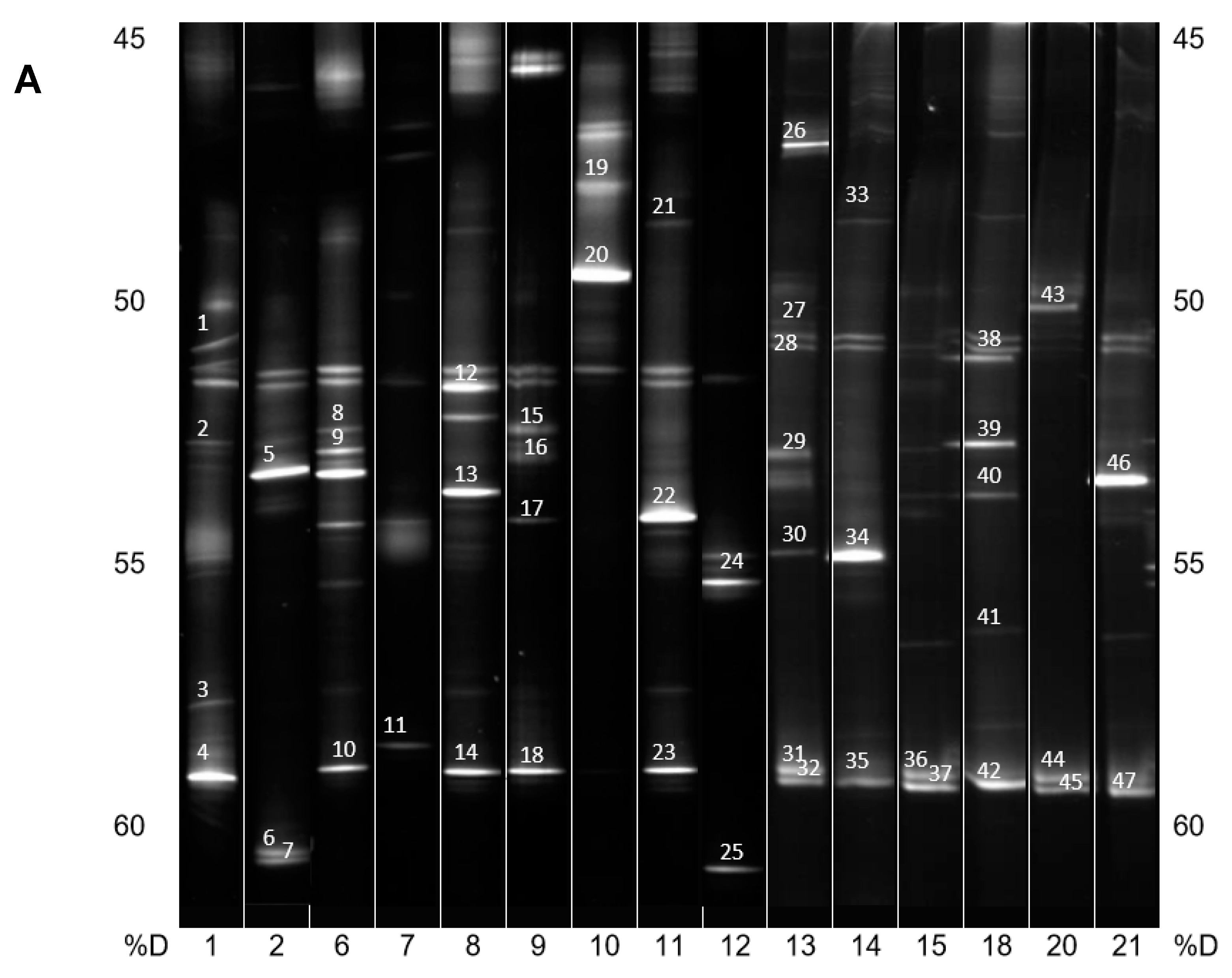
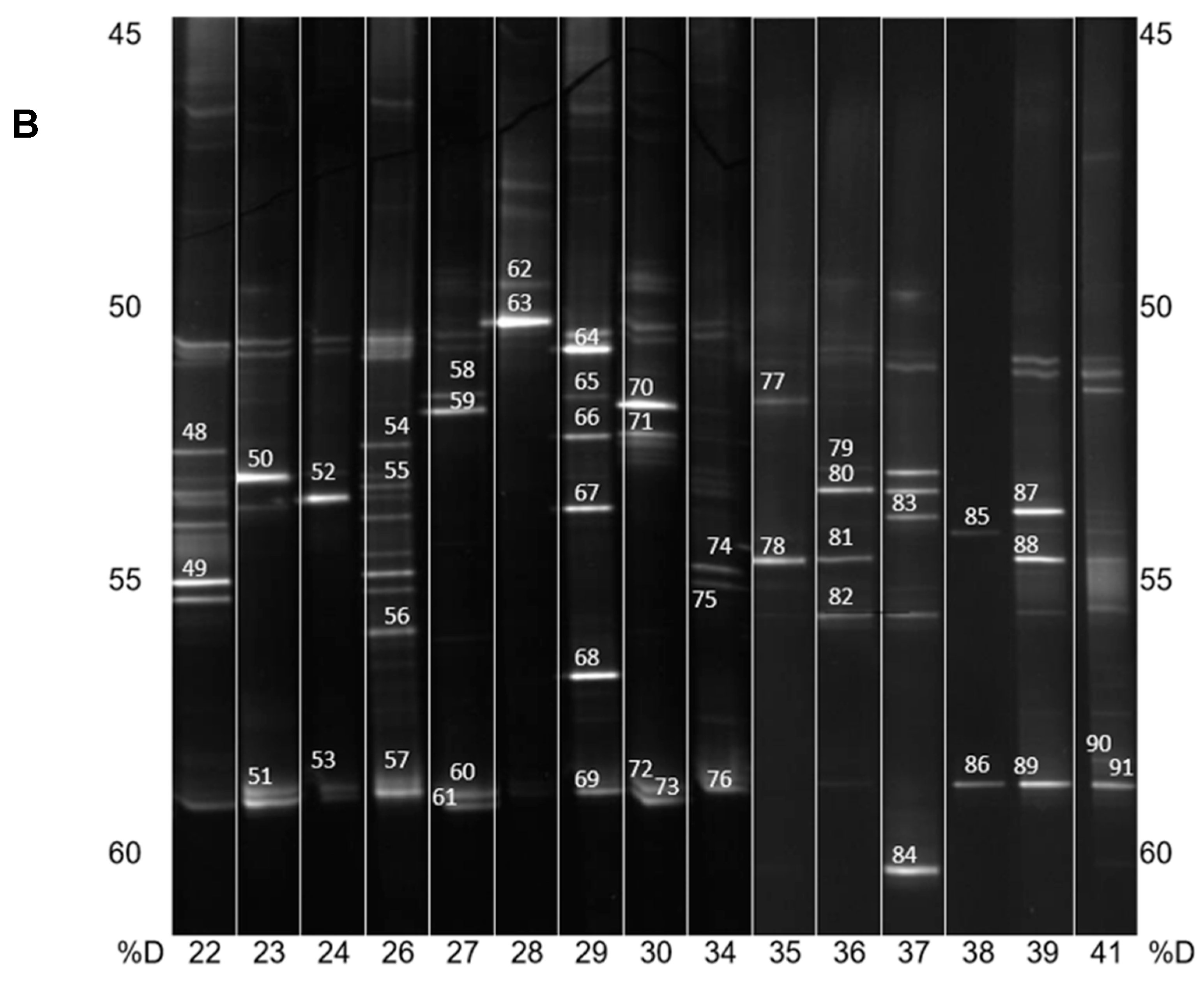
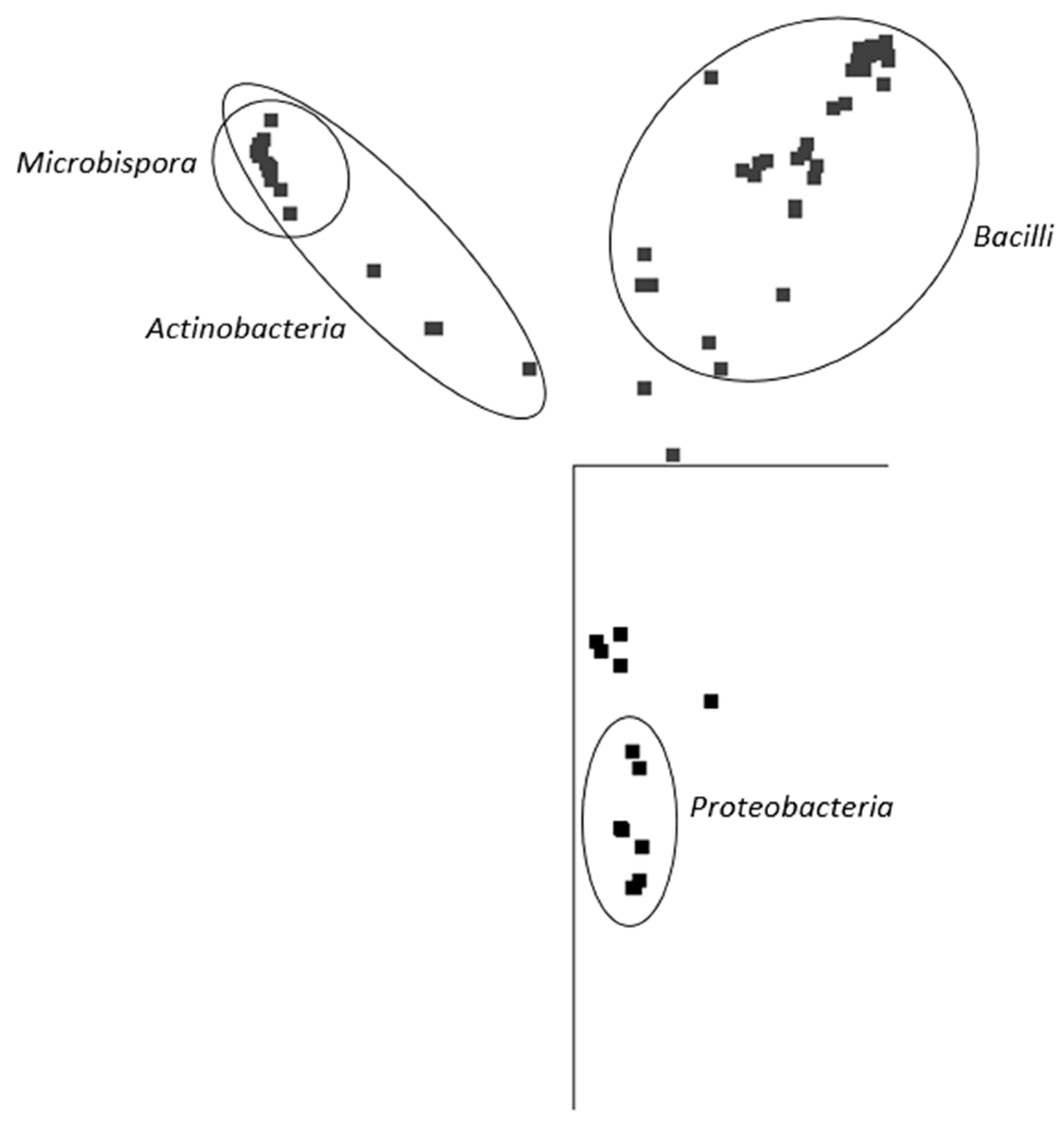
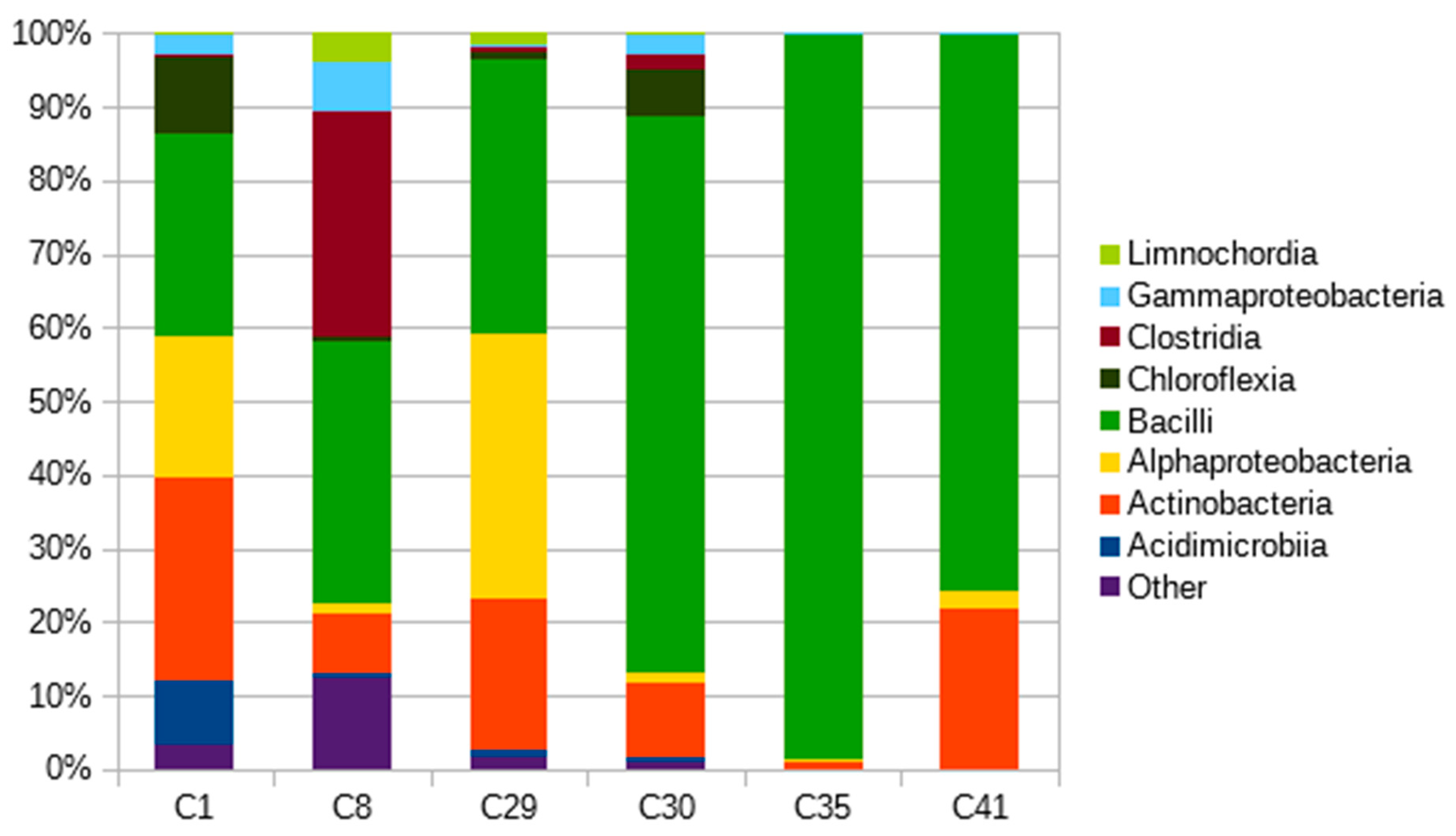
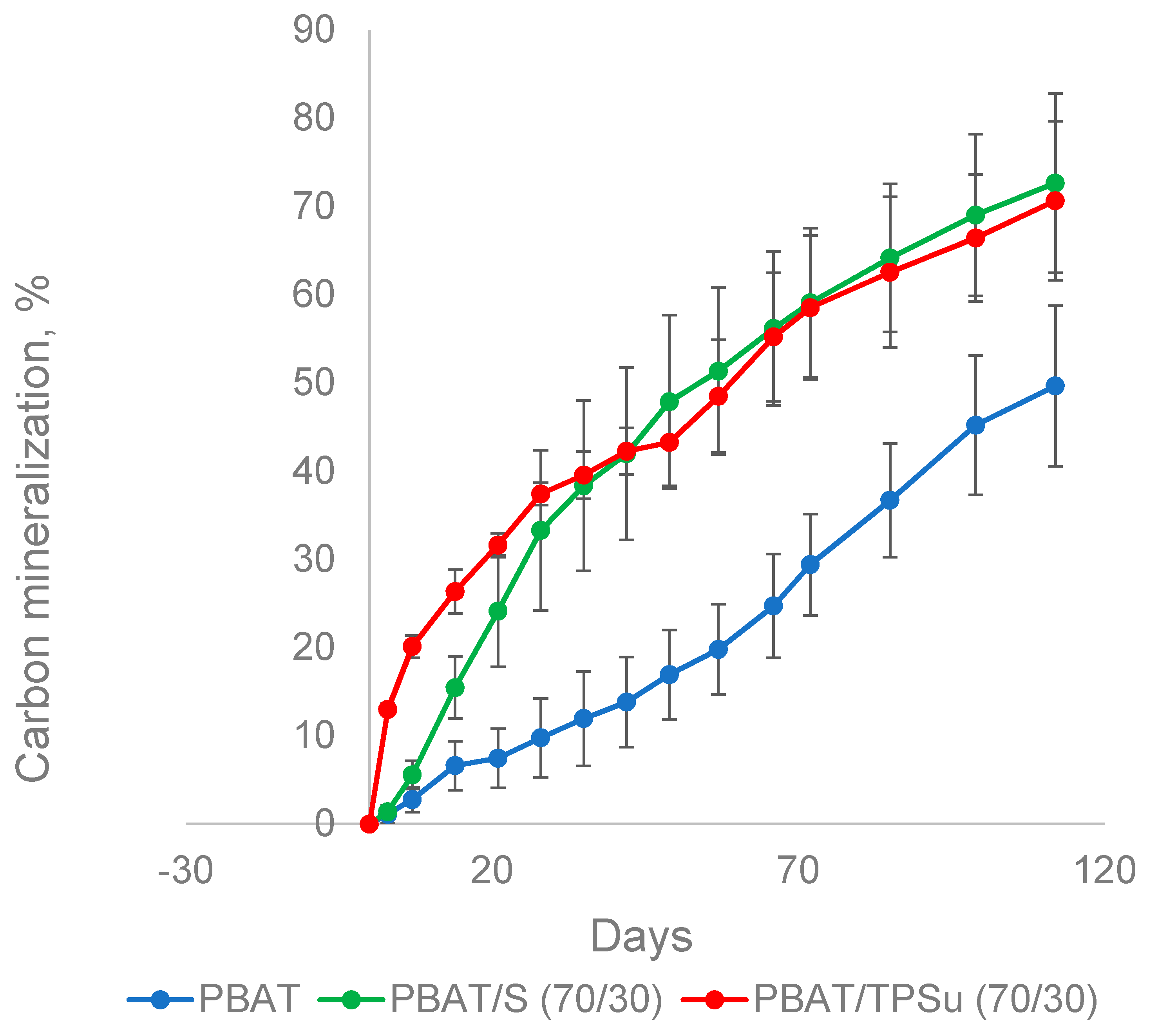
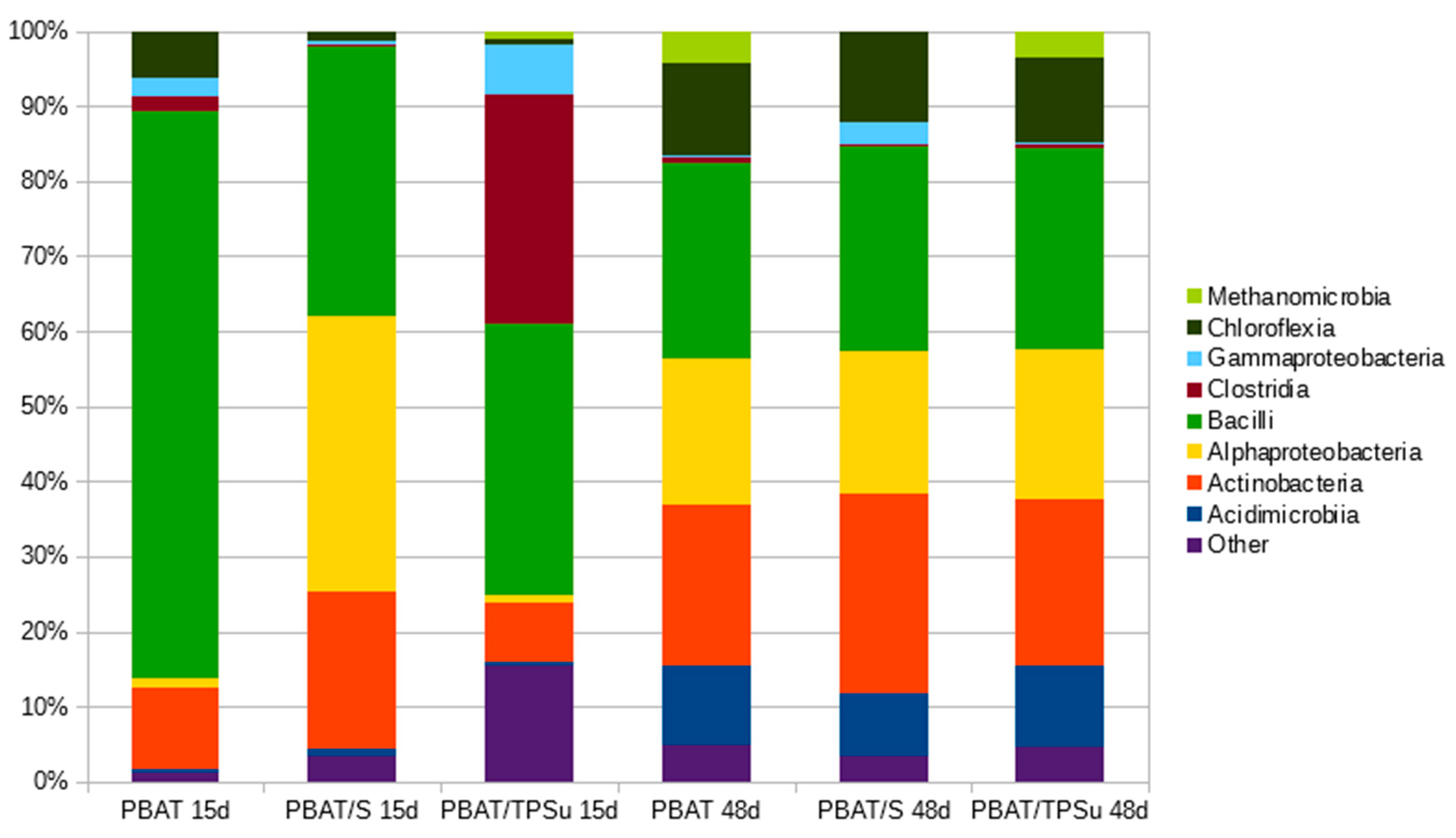

| Soil No. | Habitat | a Corg, % | Soil Type | pH | b CFU 1 × 102 Per Gram | c CFU 2 × 102 Per Gram | Band Number | Identified Bacteria | d % |
|---|---|---|---|---|---|---|---|---|---|
| 1 | Orchard | 1.3 | Fluvisol | 6.60 | 2 | 44 | 1.1 | Anoxybacilluss sp. | 97 |
| 1.2 | Paenibacillus | 92 | |||||||
| 1.3 | Thermobispora bispora | 97 | |||||||
| 1.4 | Thermobispora bispora | 97 | |||||||
| 2 | Stream bank | 1.3 | Fluvisol | 5.85 | <1 | 9.9 | 2.5 | Geobacillus sp. | 99 |
| 2.6 | Thermobispora bispora | 97 | |||||||
| 2.7 | Thermobispora bispora | 97 | |||||||
| 3 | Field | 2.3 | Luvisol | 6.2 | <1 | <1 | - | - | - |
| 4 | Field | 3.0 | Fluvisol | 6.41 | <1 | <1 | - | - | - |
| 5 | Field | 3.0 | Fluvisol | 6.59 | <1 | <1 | - | - | - |
| 6 | Grass cover | 0.8 | Luvisol | 6.10 | <1 | 5.7 | 6.8 | Aeribacillus sp. | 96 |
| 6.9 | Geobacillus caldoxylosilyticus | 99 | |||||||
| 6.10 | Thermobispora bispora | 99 | |||||||
| 7 | Stream bank | 0.8 | Fluvisol | 5.90 | <1 | 25 | 7.11 | Actinomadura rubrobrunea | 98 |
| 8 | Stream bank | 1.3 | Fluvisol | 6.05 | 1 | 15 | 8.12 | Geobacillus sp. | 77 |
| 8.13 | Paenibacillus caldisaponilyticus | 99 | |||||||
| 8.14 | Thermobispora bispora | 96 | |||||||
| 9 | Field | 1.3 | Luvisol | 6.12 | <1 | 4.6 | 9.15 | Bacillus sp. | 99 |
| 9.16 | Diaphorobacter sp. | 93 | |||||||
| 9.17 | Methylobacterium sp. | 95 | |||||||
| 9.18 | Thermobispora bispora | 96 | |||||||
| 10 | Grass cover | 1.7 | Fluvisol | 5.40 | <1 | 4.3 | 10.19 | Anoxybacillus caldiproteolyticus | 99 |
| 10.20 | Geobacillus sp. | 99 | |||||||
| 11 | Field | 1.7 | Luvisol | 6.43 | 2 | 12 | 11.21 | Geobacillus sp. | 99 |
| 11.22 | Geobacillus sp. | 99 | |||||||
| 11.23 | Thermobispora bispora | 97 | |||||||
| 12 | Forest | 3.5 | Luvisol | 5.30 | <1 | 3.3 | 12.24 | Propionibacterium | 100 |
| 12.25 | Microbispora bispora | 99 | |||||||
| 13 | Forest | 1.0 | Leptosol | 5.24 | <1 | 1.3 | 13.26 | Flectobacillus sp. | 99 |
| 13.27 | Flectobacillus roseus | 99 | |||||||
| 13.28 | Geobacillus sp. | 94 | |||||||
| 13.29 | Bacillus sp. | 99 | |||||||
| 13.30 | Methylobacterium sp. | 97 | |||||||
| 13.31 | Microbispora bispora | 96 | |||||||
| 13.32 | Actinobacteria | 88 | |||||||
| 14 | Field | 1.0 | Leptosol | 5.45 | <1 | 93 | 14.33 | Flectobacillus sp. | 99 |
| 14.34 | Flectobacillus roseus | 99 | |||||||
| 14.35 | Geobacillus sp. | 94 | |||||||
| Thermobispora bispora | 99 | ||||||||
| 15 | Field | 1.2 | Cambisol | 5.80 | <1 | 8.8 | 15.36 | Thermobispora bispora | 99 |
| 15.37 | Thermobispora bispora | 99 | |||||||
| 16 | Stream bank | 1.5 | Fluvisol | 6.27 | <1 | <1 | - | - | - |
| 17 | Field | 2.0 | Cambisol | 5.97 | <1 | <1 | - | - | - |
| 18 | Field | 1.2 | Cambisol | 6.4 | <1 | 8.7 | 18.38 | Paenibacillus sp. | 93 |
| 18.39 | Thermobacillus sp. | 95 | |||||||
| 18.40 | Aeribacillus sp. | 99 | |||||||
| 18.41 | Blastochloris sp. | 87 | |||||||
| 18.42 | Thermobispora bispora | 99 | |||||||
| 19 | Field | 2.3 | Fluvisol | 6.42 | <1 | <1 | - | - | - |
| 20 | Grass cover | 1.2 | Fluvisol | 5.93 | <1 | 7.7 | 20.43 | Geobacillus sp. | 99 |
| 20.44 | Thermobispora bispora | 99 | |||||||
| 20.45 | Thermobispora bispora | 99 | |||||||
| 21 | Field | 1.2 | Fluvisol | 5.30 | <1 | 92 | 21.46 | Geobacillus debilis | 99 |
| 21.47 | Thermobispora bispora | 99 | |||||||
| 22 | Stream bank | 3.5 | Fluvisol | 6.25 | <1 | 15 | 22.48 | Paenibacillus sp. | 88 |
| 22.49 | Alicyclobacillus | 90 | |||||||
| 23 | Stream bank | 3.5 | Fluvisol | 5.57 | 1 | 140 | 23.50 | Geobacillus caldoxylosilyticus | 99 |
| Thermobispora bispora | 99 | ||||||||
| 23.51 | |||||||||
| 24 | Orchard | 3.5 | Cambisol | 6.10 | 1 | 22 | 24.52 | Aeribacillus sp. | 99 |
| 24.53 | |||||||||
| 25 | Field | 2.3 | Chernozem | 5.75 | <1 | <1 | - | - | - |
| 26 | Forest | 1.3 | Cambisol | 5.03 | <1 | 32 | 26.54 | Alicyclobacillus | 97 |
| 26.55 | Thermobacillus sp. | 95 | |||||||
| 26.56 | Blastochloris sp. | 96 | |||||||
| 26.57 | Actinomadura sp. | 96 | |||||||
| 27 | Grass cover | 0.8 | Cambisol | 6.50 | <1 | 24 | 27.58 | Thermobispora bispora | 96 |
| 27.59 | Thermobispora bispora | 97 | |||||||
| 27.60 | Geobacillus thermoglucosidasius | 96 | |||||||
| Parageobacillus thermoglucosidans | |||||||||
| 27.61 | 99 | ||||||||
| 28 | Forest | 1.2 | Cambisol | 5.23 | <1 | 9.6 | 28.62 | Thermobispora bispora | 99 |
| 28.63 | Kyrpidia tusciae | 96 | |||||||
| 29 | Grass cover | 1.2 | Chernozem | 6.65 | <1 | 89 | 29.64 | Tuberibacillus sp. | 99 |
| 29.65 | Paennibacillus sp. | 91 | |||||||
| 29.66 | Paenibacillus sp. | 89 | |||||||
| 29.67 | Paenibacillus sp. | 94 | |||||||
| 29.68 | Anoxybacillus caldiproteolyticus | 99 | |||||||
| Anoxybacillus caldiproteolyticus | |||||||||
| 29.69 | 99 | ||||||||
| 30 | Grass cover | 1.7 | Chernozem | 6.77 | <1 | 18 | 30.70 | Thermobispora bispora | 99 |
| 30.71 | Thermobispora bispora Geobacillus sp. | 99 | |||||||
| 30.72 | Bacillus sp. | 99 | |||||||
| 30.73 | 80 | ||||||||
| 31 | Field | 3.0 | Fluvisol | 5.81 | <1 | <1 | - | - | - |
| 32 | Grass cover | 2.0 | Luvisol | 6.12 | <1 | <1 | - | - | - |
| 33 | Grass cover | 2.0 | Luvisol | 6.14 | <1 | <1 | - | - | - |
| 34 | Field | 1.4 | Luvisol | 6.72 | <1 | 70 | 34.74 | Dokdonella sp. | 97 |
| 34.75 | Thermobispora bispora | 99 | |||||||
| 34.76 | Thermobispora bispora | 99 | |||||||
| 35 | Field | 1.4 | Luvisol | 5.90 | <1 | 140 | 35.77 | Paenibacillus ehimensis | 93 |
| 35.78 | Thermoanaerobacterium | 87 | |||||||
| 36 | Field | 1.0 | Leptosol | 6.10 | 1 | 5.1 | 6.79 | Caldicellulosiruptor sp. | 97 |
| 36.80 | Pelomonas aquatica | 99 | |||||||
| 36.81 | Methylobacterium sp. | 98 | |||||||
| 36.82 | Propionibacterium sp. | 99 | |||||||
| 37 | Stream bank | 1.0 | Cambisol | 6.19 | 1 | 16 | 37.83 | Comamonadaceae bacterium | 99 |
| 37.84 | Thermobispora bispora | 99 | |||||||
| 38 | Stream bank | 1.2 | Chernozem | 6.61 | <1 | 31 | 38.85 | Geobacillus sp. | 98 |
| 38.86 | Thermobispora bispora | 98 | |||||||
| 39 | Field | 1.7 | Fluvisol | 6.7 | 2 | 31 | 39.87 | Aeribacillus sp. | 99 |
| 39.88 | Geobacillus sp. | 100 | |||||||
| 39.89 | Thermobispora bispora | 96 | |||||||
| 40 | Forest | 3.0 | Fluvisol | 5.59 | <1 | <1 | - | - | - |
| 41 | Field | 1.7 | Fluvisol | 6.75 | 2 | 13 | 41.90 | Paenibacillus sp. | 95 |
| 41.91 | Thermobispora bispora | 98 |
Publisher’s Note: MDPI stays neutral with regard to jurisdictional claims in published maps and institutional affiliations. |
© 2020 by the authors. Licensee MDPI, Basel, Switzerland. This article is an open access article distributed under the terms and conditions of the Creative Commons Attribution (CC BY) license (http://creativecommons.org/licenses/by/4.0/).
Share and Cite
Šerá, J.; Kadlečková, M.; Fayyazbakhsh, A.; Kučabová, V.; Koutný, M. Occurrence and Analysis of Thermophilic Poly(butylene adipate-co-terephthalate)-Degrading Microorganisms in Temperate Zone Soils. Int. J. Mol. Sci. 2020, 21, 7857. https://doi.org/10.3390/ijms21217857
Šerá J, Kadlečková M, Fayyazbakhsh A, Kučabová V, Koutný M. Occurrence and Analysis of Thermophilic Poly(butylene adipate-co-terephthalate)-Degrading Microorganisms in Temperate Zone Soils. International Journal of Molecular Sciences. 2020; 21(21):7857. https://doi.org/10.3390/ijms21217857
Chicago/Turabian StyleŠerá, Jana, Markéta Kadlečková, Ahmad Fayyazbakhsh, Veronika Kučabová, and Marek Koutný. 2020. "Occurrence and Analysis of Thermophilic Poly(butylene adipate-co-terephthalate)-Degrading Microorganisms in Temperate Zone Soils" International Journal of Molecular Sciences 21, no. 21: 7857. https://doi.org/10.3390/ijms21217857
APA StyleŠerá, J., Kadlečková, M., Fayyazbakhsh, A., Kučabová, V., & Koutný, M. (2020). Occurrence and Analysis of Thermophilic Poly(butylene adipate-co-terephthalate)-Degrading Microorganisms in Temperate Zone Soils. International Journal of Molecular Sciences, 21(21), 7857. https://doi.org/10.3390/ijms21217857





